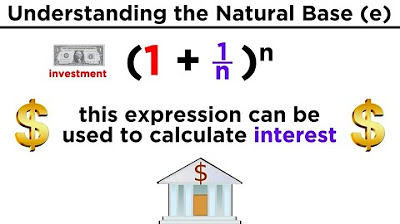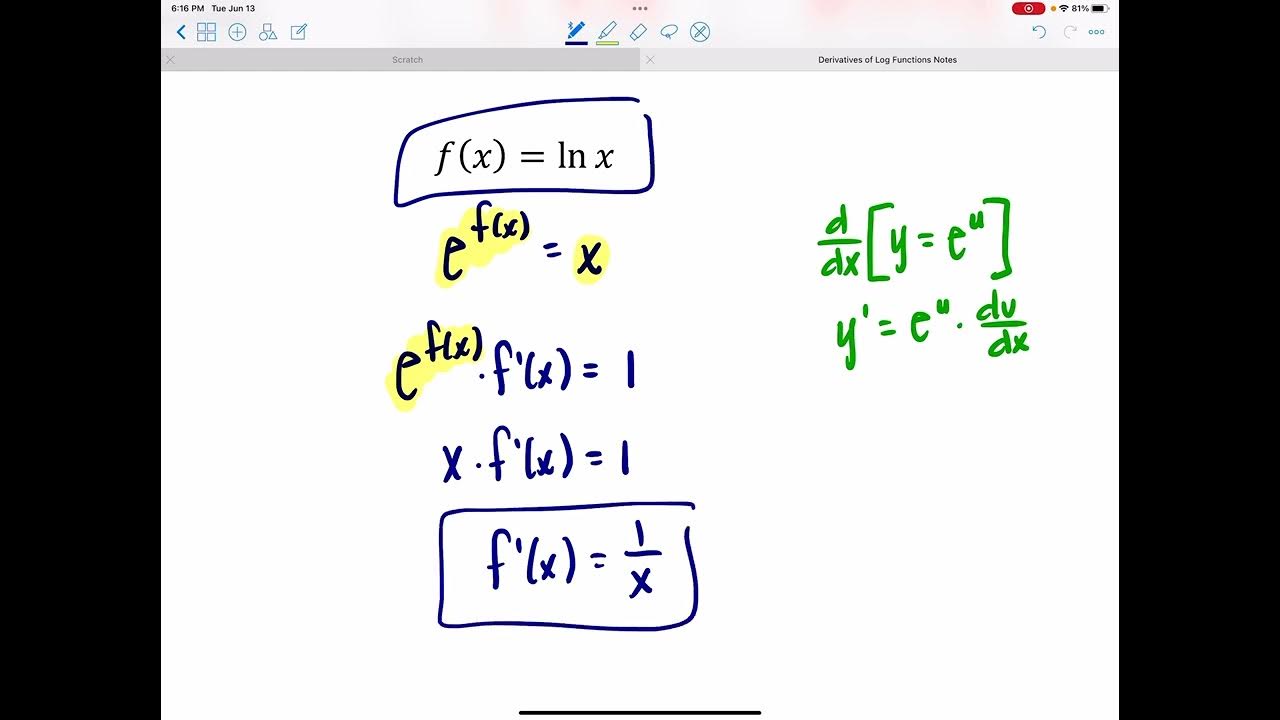Logarithmic scale | Logarithms | Algebra II | Khan Academy
TLDRThe script offers an insightful exploration of linear and logarithmic scales, starting with a familiar linear number line where each unit movement equates to adding or subtracting a fixed value. It then introduces a logarithmic number line, beginning at 1, where movement corresponds to multiplication or division by a constant factor, such as 10. The video illustrates how this scale allows for a broader range of values, from very small to very large, and how fixed distances on a logarithmic scale represent consistent scaling factors, making it a valuable tool for understanding exponential relationships and human perception.
Takeaways
- 📏 The script introduces the concept of linear scales commonly used in math classes, represented by a number line starting at 0 and moving in increments of 10.
- 🔍 It explains that moving a fixed distance to the right on a linear scale represents adding a constant value (e.g., 10), and to the left represents subtracting that value.
- 🔢 The script demonstrates that fractions and whole numbers can be represented on the linear scale by moving half the distance for fractions, like moving halfway to represent 5.
- 📉 The concept of a logarithmic scale is introduced as an alternative way of representing numbers, starting at 1 instead of 0, which is significant because you cannot divide by zero in logarithms.
- 🌐 On a logarithmic scale, moving a fixed distance to the right means multiplying by a constant factor (e.g., 10), and to the left means dividing by that factor.
- 📈 Logarithmic scales allow for a broader representation of numbers, from very small fractions like 1/100 to very large numbers like 10,000.
- 🔗 The script illustrates that moving a fixed distance on a logarithmic scale corresponds to a consistent scaling factor, which is a key property of logarithmic scales.
- 📊 The logarithmic scale is shown to be useful for plotting a wide range of values that cannot be easily represented on a linear scale due to their magnitude.
- 🤔 The script encourages viewers to think about why the logarithmic scale starts at 1 and to ponder the implications of this starting point.
- 📚 It explains how to plot numbers on a logarithmic scale by using the concept of logarithms and powers, such as finding where to place 100 by asking '10 to what power equals 100?'
- 📉 The script uses the example of plotting numbers like 2, 5, and 3 on the logarithmic scale to demonstrate how distances on the scale correspond to multiplication by powers of 10.
Q & A
What is a linear scale?
-A linear scale is a type of scale commonly used in mathematics where each unit increase or decrease is constant, representing equal intervals of numerical values along a number line.
How does moving a certain distance on a linear number line affect the value?
-Moving a certain distance to the right on a linear number line adds a fixed amount (like 10) to the current value, while moving the same distance to the left subtracts that fixed amount.
What is the starting point for a logarithmic number line?
-A logarithmic number line typically starts at 1, as opposed to a linear number line which starts at 0.
How does the movement on a logarithmic number line differ from a linear number line?
-On a logarithmic number line, moving a certain distance to the right multiplies the starting value by a fixed factor (like 10), and moving to the left divides the starting value by that factor.
Why can't a logarithmic number line start at 0?
-A logarithmic number line can't start at 0 because logarithms of non-positive numbers are undefined, as you cannot take the log of 0 or a negative number in the real number system.
What does moving half the distance on a linear number line represent?
-Moving half the distance on a linear number line represents adding or subtracting half the fixed amount, for example, moving half the distance to add 10 would add 5 to the current value.
How can you find the position of a number like 5 on a logarithmic number line?
-To find the position of a number like 5 on a logarithmic number line, you can calculate the base 10 logarithm of 5 and move that fraction of the distance to the right from the starting point (1).
What is the significance of moving a fixed distance on a logarithmic scale?
-Moving a fixed distance on a logarithmic scale means you are multiplying the starting value by a constant factor, which can be represented by an exponent.
How does the logarithmic scale help in plotting a broader range of numbers?
-The logarithmic scale allows for plotting a much broader range of numbers by compressing the scale at higher values, providing granularity at both small and large scales.
Why does the logarithmic scale provide a better understanding of human perception?
-The logarithmic scale provides a better understanding of human perception because many of our senses, like hearing and vision, perceive changes in a logarithmic rather than linear fashion.
How can you determine the position of 100 on a logarithmic number line?
-To determine the position of 100 on a logarithmic number line, you calculate how many times you need to multiply 10 by itself to get 100, which is 2, and then move that many distances to the right from the starting point (1).
What is the relationship between the position of a number on a logarithmic scale and its logarithm?
-The position of a number on a logarithmic scale corresponds to the base 10 logarithm of that number. For example, the base 10 logarithm of 100 is 2, so 100 is plotted two distances to the right from the starting point.
Outlines
📏 Introduction to Linear Scales
The script begins with an introduction to linear scales, commonly seen in mathematics. It illustrates the concept with a number line starting at zero and explains how moving a certain distance to the right adds ten, and to the left subtracts ten. This is demonstrated by moving from 0 to 10, 20, 30, and so on, and in the opposite direction to negative numbers. The script also touches on fractions, explaining that moving half the distance would represent half of ten, or 5. The concept is then extended to consider a logarithmic scale, which is introduced as a different way of thinking that will be useful for understanding logarithmic scales.
📐 Understanding Logarithmic Scales
The second paragraph delves into the concept of logarithmic scales, starting with the number line at 1, as opposed to 0, and explaining the reason behind this choice. The movement on this scale is associated with multiplication by a factor, rather than addition or subtraction. The script demonstrates how moving a fixed distance to the right on a logarithmic scale means multiplying the starting point by 10, and to the left means dividing by 10. It also explains how to plot numbers like 100, 2, and others on the logarithmic scale using the concept of exponents and logarithms. The ability to fit a broader spectrum of numbers on the logarithmic scale is highlighted, as well as the granularity it offers at both small and large scales.
🤔 Human Perception and Logarithmic Scales
The final paragraph discusses the implications of logarithmic scales, particularly how moving a fixed distance on this scale results in a multiplication by a fixed constant. It also addresses the peculiarity of numbers not being lined up as they are on a linear scale, with larger jumps between certain numbers and smaller jumps between others. The script uses examples to show how numbers like 3, 6, 7, 8, and 9 can be plotted on the logarithmic scale. It concludes by emphasizing the usefulness of logarithmic scales and their relevance to human perception, suggesting that our understanding and perception of many things align more closely with logarithmic scales.
Mindmap
Keywords
💡Linear Scales
💡Number Line
💡Multiplication
💡Division
💡Logarithmic Scale
💡Exponents
💡Logarithm
💡Base 10
💡Granularity
💡Human Perception
Highlights
Introduction to linear scales and their commonality in math classes.
Explanation of a linear number line starting from 0 and moving in increments of 10.
Demonstration of how moving a fixed distance on a linear scale equates to adding a constant value.
Illustration of moving in the opposite direction on the linear scale, showing subtraction of 10.
Introduction of fractions on the linear scale, showing how 5 is represented as half the distance of 10.
Conceptualization of moving a fixed distance on a logarithmic scale starting from 1, as opposed to 0.
Description of moving right on a logarithmic scale as multiplying by a constant factor, such as 10.
Explanation of moving left on a logarithmic scale as dividing by a constant factor, such as 10.
Visualization of the difference between linear and logarithmic scales and their range of values.
Discussion on the broader spectrum of values that can be represented on a logarithmic scale.
Analysis of fixed distance movement on a logarithmic scale equating to scaling by a fixed factor.
Introduction of the concept of exponents in the context of logarithmic scales.
Method of plotting numbers on a logarithmic scale using base 10 logarithms.
Explanation of how to determine the position of numbers like 2 and 100 on a logarithmic scale.
Demonstration of plotting intermediate values like 5 on the logarithmic scale using division.
Calculation of the logarithm of 3 to find its position on the logarithmic scale.
Explanation of how to plot numbers like 6, 7, 8, and 9 on the logarithmic scale using multiplication.
Discussion on the practical applications and the human perception aspect of logarithmic scales.
Final thoughts on the intuition behind logarithmic number lines and their usefulness.
Transcripts
5.0 / 5 (0 votes)
Thanks for rating:





